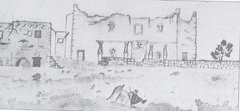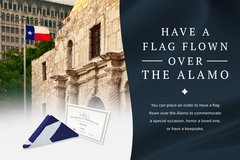Dr. R. Bruce Winders, Former Alamo Director of History and Curator
For many students who learned about the Battle of the Alamo, the lesson stopped once General Antonio López de Santa Anna attacked the old fortified mission on the morning of March 6, 1836 and put its garrison to the sword. The victorious general marched his army eastward to a fateful meeting with the Texan Army at a place called San Jacinto. Charging Texans crying “Remember the Alamo!” routed Santa Anna’s troops in a lopsided battle where they avenged the death of Travis’ small band. The war was over and Texas had won.
As is usually the case, there is more to the story. Santa Anna and his government planned to drive the American colonists out of Texas and replace them with settlements made up of discharged Mexican soldiers and their families. San Antonio de Béxar had always been a key town in Texas. Santa Anna did not abandon it when he marched east, but instead left 1000 soldiers under General Juan Andrade with orders to repair the Alamo’s battle-scarred fortifications so it could be defended in case of future attacks on the town. Andrade put his men to work doing just that until he received word of Santa Anna’s defeat at San Jacinto and orders to rejoin the main Mexican Army at Matamoros. Before he left, though, he destroyed all of the fortification at the Alamo.
Joseph H. Barnard, an American doctor spared execution at Goliad and sent to San Antonio to care for wounded Mexican soldiers there, noted in his journal on May 22 that, “General Andrade has received orders to destroy the Alamo. They are now busy as bees, soldiers, convicts and all, tearing down the walls &c.” [Barnard, 33.] Several days later Barnard further reported,
“As the troops left town this morning, a large fire streamed up from the Alamo, and as soon as they had fairly left Dr. Shackelford and myself, accompanied by Senor Reriz [sic] and some of the citizens, walked over to see the state in which they had left it. We found the fire to proceed from a church, where a platform had been built, extending from the great door to the top of the wall on the back side, for the purpose of taking up the artillery to the top of the church. This was made with wood and was too far consumed for any attempt to be made to extinguish the fire. The walls of the church being built of solid masonry, of course could not be but little injured by the fire. The Alamo was completely dismantled, all the single walls were leveled, the fossee [i.e., ditches] filled up, and the pickets torn up and burnt.” [Barnard, 33–34.]
San Antonio remained largely deserted following Andrade’s departure, owing to the rumors of a renewed Mexican campaign against Texas. Rumors of this second campaigned included the Cherokee and Comanche as Mexico’s allies.
San Antonio’s population gradually increased as previous residents returned and new settlers arrived. The area remained dangerous, though, since hostilities still existed between residents and Mexico and Indian tribes.* The Alamo resumed its traditional role as military barrack, housing soldiers serving the Republic of Texas for short periods of time in the summer 1836, the winter of 1839, and again in the winter of 1841–42.
In 1841 the Republic of Texas confirmed the Catholic Archdiocese of Texas’ ownership of the old mission compound and its remaining structures. San Antonio’s city council contested the ruling, claiming that the Alamo belonged to the city. The council even approved the selling of stones from the Alamo’s buildings to residents needing cut stone for construction projects. The families of several former mission converts continued to live in the houses located along the west wall.
Samuel A. Maverick, who escaped death at the 1836 battle because his fellow volunteers sent him to the Constitutional Convention at Washington on the Brazos River to cast their vote for independence, took an interest in the future development of the plaza. By the late 1840s Maverick owned several lots along the old west and north walls. The Alamo was on the verge of a new phase in its history.



